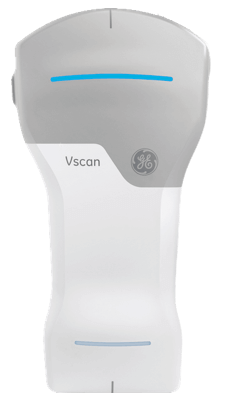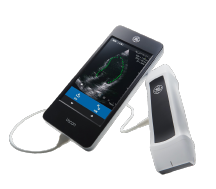
The handheld ultrasound exam offers incredible potential for today’s primary care physicians (PCPs) — it can, and should, be used as a key diagnostic tool. According to a study in The World Book of Family Medicine, “Ultrasonography should be a diagnosis tool beside the stethoscope in the general practitioner office … the two instruments should be considered as complementary.”
Further, a study in PLoS One identified that “after a simple and short training course, a pocket-sized ultrasound device examination can be used in addition to a physical examination to improve the answer to … common clinical questions concerning in- and outpatients and can reduce the need for further testing.”
Specifically, a focused ultrasound exam may be used to complement the PCP’s physical examination in three common diagnostic areas: right upper quadrant pain; flank pain; and deep vein thrombosis (DVT).
Right Upper Quadrant Pain
Right upper quadrant pain is a common presentation in primary care. The handheld ultrasound exam of the right upper quadrant of the abdomen can look for signs of gross abnormalities of the liver and gallbladder.
Point of care ultrasound may be used to identify the presence of gallstones and to assess for acute cholecystitis by detecting Murphy sign, anterior gallbladder wall thickening and pericholecystic fluid. The handheld ultrasound may also be used to assess potential bile obstruction by measuring the common bile duct diameter. This may help the physician pursue non-gallbladder sources of epigastric discomfort.
Flank Pain
When it comes to flank pain, a handheld ultrasound device may be used to assess the kidneys and, specifically, to look for hydronephrosis, identify renal or ureteral stones and to check the post-void residual bladder volume. This may provide a physician with more context in relation to the physical exam.
A study in Urology noted that a urologist “using handheld-pocket-size device is equivalent to a sonographist-performed ultrasound study using a standard device in most parameters examined. The handheld device can be used in evaluating the upper and lower urinary tract with the exception of renal masses and therefore can be of great assistance in a wide variety of the daily urological practice scenarios.”
Deep Vein Thrombosis
There is a potential benefit in using handheld ultrasound devices when dealing with DVT. According to the Journal of the American College of Cardiology: Cardiovascular Imaging, “The accurate and immediate decision-making allowed by the pocket-size ultrasound examination (PUE) has the potential to exert a significant impact on the current diagnostic strategies for DVT. Positive PUE can make other diagnostic or therapeutic procedures available earlier for the patient without standard ultrasound examination.”
Handheld ultrasound devices can potentially allow physicians to scan anyone suspected of having DVT without them having to wait for blood test results. A paper in Thrombus stated that “reducing the time to diagnose DVT could potentially avoid the use of self-injected low molecular weight heparin by patients.”
Training for Success
As with any technology, getting the proper training is a key component for reaching positive results. An article in the Annals of Internal Medicine encourages “residency training programs to teach PoCUS, practicing hospitalists to incorporate it into daily practice, and hospitals and hospital medicine programs to provide easy access to the necessary technology.”
A study in BMC Medical Education concluded that “medical students with minimal training were able to use (a pocket-size imaging device) as a supplement to standard physical examination and successfully acquire acceptable relevant organ images for presentation and correctly interpret these with great accuracy.” And, according to the Annals of Internal Medicine study, the “use of ultrasound by hospitalists will continue to modernize the bedside evaluation and streamline the diagnostic process.”
By adding handheld ultrasound to the routine examination, PCPs may have the potential to reduce waiting times and ultimately deliver better care to those who need it.




